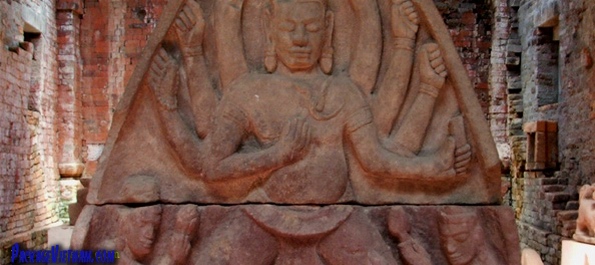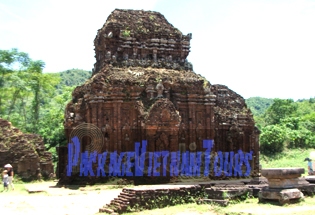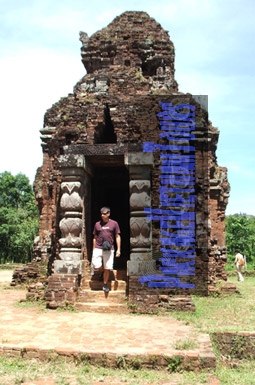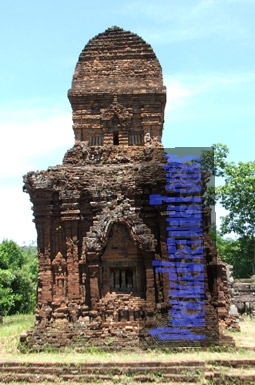
My Son
The site of My Son is 65 km southwest of Hoi An and Da Nang; only 10km from Tra Kieu (The City of Lion, the Capital City of Champa). The complex comprises series of Hindu-like temples built in a valley sourrounded by mountains. At the height it's said that there were 70 structures of temples towering at the site. Nowadays only 25 of the once splendid structures remain due to time and war damages.
The construction of My Son might have started from the 4th century A.D. Studies have concluded that the first wooden temples built at My Son was in the 4th century. But these temples were burned down completely in a fire. And from the 7th century successive temples were added to My Son complex by different Cham Kings.
Each Cham King succeeded the throne would built more temples at My Son and dedicated them to their God. My Son was like a connection between the Cham people and their God. Besides My Son was the place most important ceremonies of the kingdom would take place and My Son was also the place where royal tombs were found.

The ruins at My Son used to be covered by jungles
Each group of temples at My Son would include a main stupa temple called Kalan and subsidiary temples encircling the main one. The temple gates would face east receiving the sun beams or to turn to their God(?). At ceremonies in the past, the devotees would pray traversing around the temples in the clockwise direction. At ceremonies the Cham would pour the holy water on the Linga. The water would drip through the Joli and trickle down.
The stupas architecture is comprised of 3 parts: the top is like Mount Meru, the middle is like Linga (Masculine Power) and the base is like Joli (Feminin). There's also a statue of God Shiva, the protector of the kingdom. The techniques the Cham used to build their temples remain to be a mystery. Take a closer look at each structure you may notice that there seems to be no glue between the bricks to stick them together. Come and visit My Son you may solve the riddle!

A traveling coming out of a temple ruin
Champa culture is the evidence of Indian influence in Vietnam apart from the Chinese one. Traveling to My Son Cham Ruins you may find it disappointing if compared to Angkor Wat of Cambodia in the grandeur. But you may also want to know that My Son Cham Ruins were built several centuries earlier than any Hindu-influenced structures in South East Asia.
My Son Cham Ruins are still in serious degradation even though many attempts have been made to protect it. More funds and more scientific efforts are needed for this complex.

The once a great structure now is in ruin
Travel and Tours
The tour to My Son would take half a day. It's better to do the tour in the early morning as it may get very hot in late morning and afternoon in the summer.
The drive from Da Nang or Hoi An to My Son Cham Ruins takes 1h15'. All cars or motorbikes would stop at a place 1km from the ruins. You'll cross a footbridge to the otherside of the river and will be transferred to the ruins by Russian jeep. Alternatively you can walk from the river which takes 20 minutes.
Visiting the site of My Son would take 1-2 hours. On the way back you can drive the same road back or take a boat trip with visits to a ceramics village or carpentry village on the riverside before docking at Hoi An Ancient Town.

A rare temple of My Son in good shape
Accommodation
There is no hotel in My Son at the time of writing. Travelers would take a day trip to this site from Hoi An or Da Nang.
Getting there and away
My Son is 70km from Hoi An or Da Nang. The road is good and scenic. You drive south from Hoi An or Da Nang to Road 1 until arriving at Buu Dien Duy Xuyen (Post Office of Duy Xuyen Town) where you turn right and drive straight through the country road to My Son Cham Ruins.
Vietnam Travel Guides
- Activities
- Arts & Entertainment
- Bac Kan
- Bac Lieu
- Bac Ninh
- Battlefields
- Ben Tre
- Buon Ma Thuot
- Ca Mau
- Can Tho
- Cao Bang
- Cat Ba Island
- Chau Doc
- Climate
- Cu Chi Tunnel
- Da Lat
- Da Nang
- Dangers & Annoyances
- Economy
- Embassies & Consulates for Vietnam
- Embassies & Consulates of Vietnam
- Festivals & Events
- Food & Drinks
- Geography
- Gia Lai



 Print
Print 





